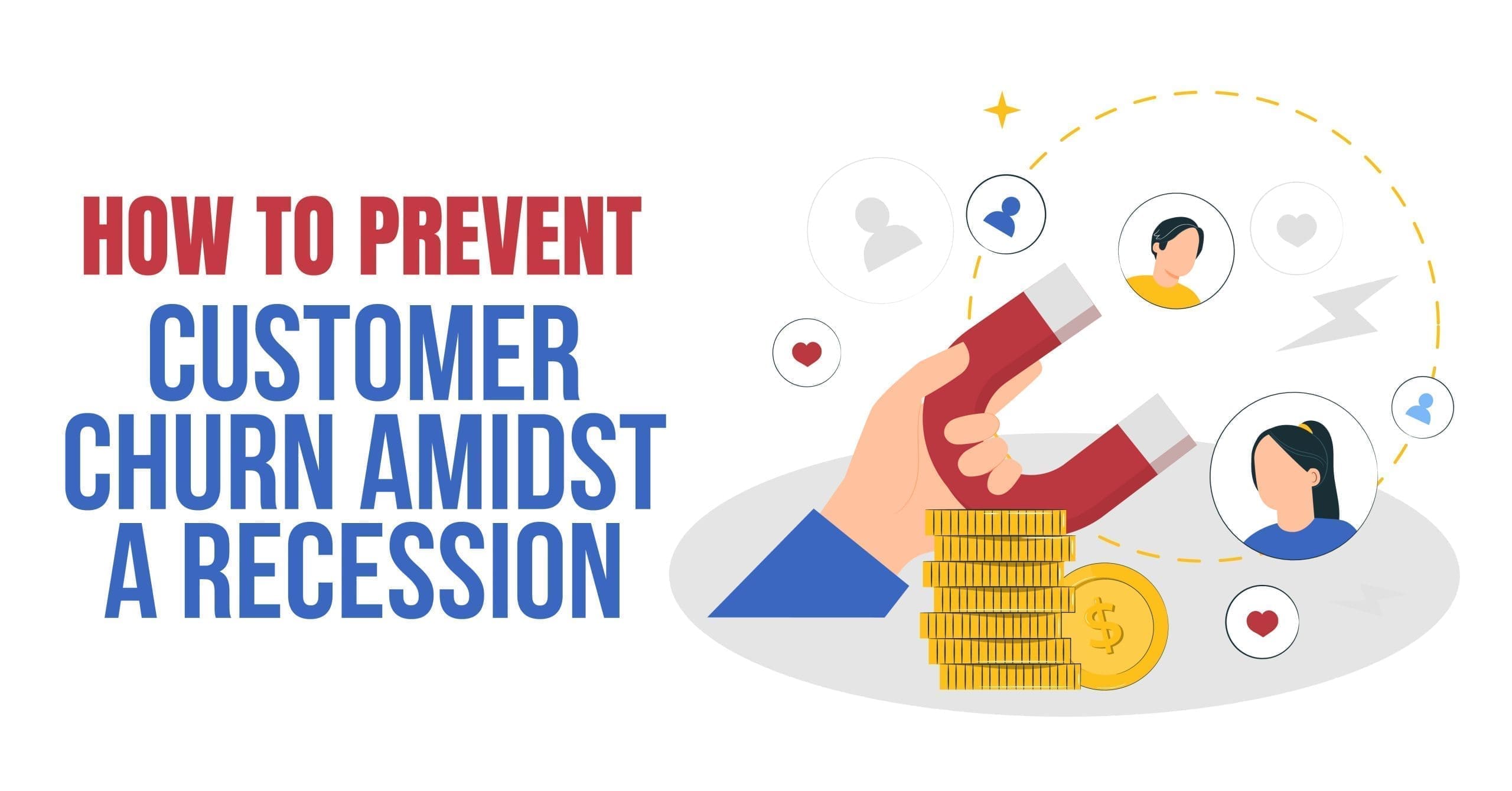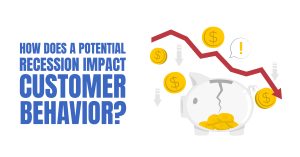
How to Prevent Customer Churn Amidst a Recession

As the economy faces a potential recession in 2023, businesses across many industries contend with retaining their customers amid financial uncertainties. For eCommerce brands, customer churn can be a significant threat as consumers tighten their budgets and cut back on discretionary spending.
To prevent turnover, it’s essential to understand its causes in eCommerce. Common factors include poor customer experience, uncompetitive pricing, lack of relevant product offerings, and insufficient support, which can be exacerbated during a recession. In this post, we’ll dive deeper into these issues, then explore strategies for reducing eCommerce customer churn in a recession.
What is customer churn?
In eCommerce, customer churn is a critical metric that indicates the percentage of customers who stop purchasing from a business over a given period. It’s an important factor that impacts business revenue, profitability, and long-term sustainability. Pinpointing its underlying causes is essential for eCommerce brands to take steps to mitigate it and increase their customer retention.
What causes consumer churn?
In today’s highly competitive landscape, customers have a wealth of options, and multiple factors, both large and small, can easily drive them to your competitors. We’ve found the main culprits to be:
- A poor customer experience: Customers expect a seamless and enjoyable purchasing process, from the moment they land on your eCommerce website through checkout and delivery. If the site design is confusing, or if the checkout process is lengthy or unreliable, shoppers may abandon their carts and never return. Slow shipping, inaccurate product descriptions, and poor customer support also contribute to a negative experience that can lead to churn.
- Noncompetitive pricing: Consumers are highly price-sensitive and constantly seek out the best deals. Ecommerce businesses that sell their products or services at high prices will likely drive customers away, particularly during times of economic uncertainty. If a recession occurs in 2023, bringing with it a high risk of inflation, eCommerce businesses must be particularly careful about pricing to avoid customer churn.
- Inflation: Inflation leads to higher costs of production and materials, which, in turn, affects the prices of products and services. As a result, eCommerce businesses have to adjust their pricing to keep up with the changing economic landscape, with customers becoming more sensitive to these changes. Inflation can also impact shipping costs and produce longer wait times for customers, and poor delivery experience is a sure-fire way to encourage customer churn.
- Lack of relevant product offerings: Shoppers expect to find products that meet their unique needs and interests, and businesses that fail to deliver on those expectations may lose customers to competitors that do. During a recession though, consumers are all but certain to cut back on discretionary spending, so eCommerce businesses must offer products that are essential and relevant to their customers to avoid churn.
- Insufficient support: Customers expect prompt and responsive customer service when they have questions or issues with their orders. Less-than-satisfactory support often causes customers to feel frustrated and turn to competitors that offer better customer service. In times of economic uncertainty, consumers may be particularly anxious about their purchases, so top-notch support is crucial to prevent frustration and churn.
How does a potential recession impact customer behavior?
The possibility of a recession setting can have a significant influence on eCommerce customer behaviors. As people become more cautious and limit their spending, eCommerce businesses may find themselves facing increased competition, reduced sales, and higher than normal customer churn. Other effects are:
- A shift towards value-based purchasing: Customers become more price-sensitive and look for ways to stretch their budgets further, such as purchasing discounted or clearance items. As such, eCommerce businesses may need to adjust their product offerings and promotions to cater to this shift.
This, in turn, could lead to greater competition, particularly among those that sell essential products or services. Companies that offer the best value and competitive pricing are likely to see an increase in customer traffic and sales.
- Greater emphasis on customer service and support: As customers become more cautious about their purchases, they may seek out businesses that offer responsive and reliable customer support. Investing in customer service and support may thus yield increased customer loyalty and retention. Happy customers are repeat customers!
- Slower shipping and longer delivery times: When faced with economic uncertainty, businesses may need to cut back on their logistics and supply chain expenses, which results in longer shipping times and limited delivery options. This change is likely to anger customers and can contribute to churn. Businesses that maintain fast and reliable shipping and delivery options even during a recession better position themselves for higher customer loyalty and retention.
- Shaken customer trust and confidence: Customers may also be more wary of businesses that have a history of poor customer service, noncompetitive pricing, or inadequate support and choose to avoid them for safer options. So, it’s important to have an established reputation for trustworthiness, reliability, and quality.
Tips to reduce churn
No matter how stellar your offerings or how optimized your operations, some customer churn is to be expected, though the rate varies by industry and product type: For subscription businesses, a 5% monthly churn rate is considered average, while single-purchase businesses (e.g., skin care, fashion, lifestyle, personal products) should expect a much higher churn rate at roughly 75%. This equates to about one in four customers returning.
During times of financial uncertainty, such as a recession, customer and buying behaviors inevitably shift. For eCommerce businesses, this might look like higher than usual rates of customer churn, which impact your customer lifetime value (CLV). Because this metric is important to your profit margins (and because it costs more to attract new customers than to keep existing ones), ensuring you reduce churn is especially crucial. Check out our recommendations below to maintain a healthy consumer base.
Stay in stock
Running out of stock of a particular product is a major contributor to churn in eCommerce. When customers are unable to purchase the products they want, they grow frustrated and are likely to turn to competitors who do have the items in stock.
To avoid this issue, regularly monitor your inventory and ensure you have enough stock of your most popular items. Additionally, communicate with consumers when you restock items; this encourages them to come back and make a purchase.
If you find yourself back-ordered, don’t despair: You have a few options to manage backorders more easily.
Push subscriptions and loyalty benefits
Providing loyalty benefits and rewards incentivizes buyers to remain loyal to your business. By encouraging customers to subscribe to your products or services, you can increase customer retention and reduce churn.
For instance, you could offer a discount or free product to customers who make regular purchases or reach a certain spending threshold. The more shoppers feel appreciated and rewarded for their loyalty, the more likely they are to make repeat purchases with you.
For a great subscription program to copy, check out Amazon Subscribe & Save.
Offer free shipping
High shipping costs can be a significant barrier to entry for customers looking to purchase. Offering free shipping reduces the likelihood of people abandoning their carts due to expensive shipping fees. It also increases customer satisfaction and loyalty, as they feel they’re getting a better deal and thus a more enjoyable shopping experience.
Want to really wow your customers? Offer free returns too.
Highlight value over price
While price is a significant factor in a purchase, highlighting the value of a product or service over its price is also an effective way to reduce churn. Emphasize the quality, benefits, and unique features of your items both to differentiate yourself from your competitors and justify higher prices.
Customers who feel they’ve found a high-quality product that meets their needs and brings additional value stay loyal to a business longer. This avoids having to race to the bottom on pricing and potentially cutting into your profit margins.
Craft unique bundles
Bundles of related products or exclusive items give customers something unique and appealing that they can’t find elsewhere. For example, include an item you don’t sell regularly in your product catalog. This encourages them to make additional purchases and stay loyal to your brand. Bonus: Bundling is a great way to boost your average order value.
Wrapping up — Take action to hold onto your followers
Reducing customer churn in eCommerce requires a proactive and customer-centric approach, especially during a recession. You can increase your retention rate by ensuring stock availability, encouraging subscriptions and loyalty, offering free shipping, highlighting value over price, and assembling bundles and exclusive items. Invest in these strategies to nurture a loyal customer base and drive long-term success throughout various economic ups and downs.



